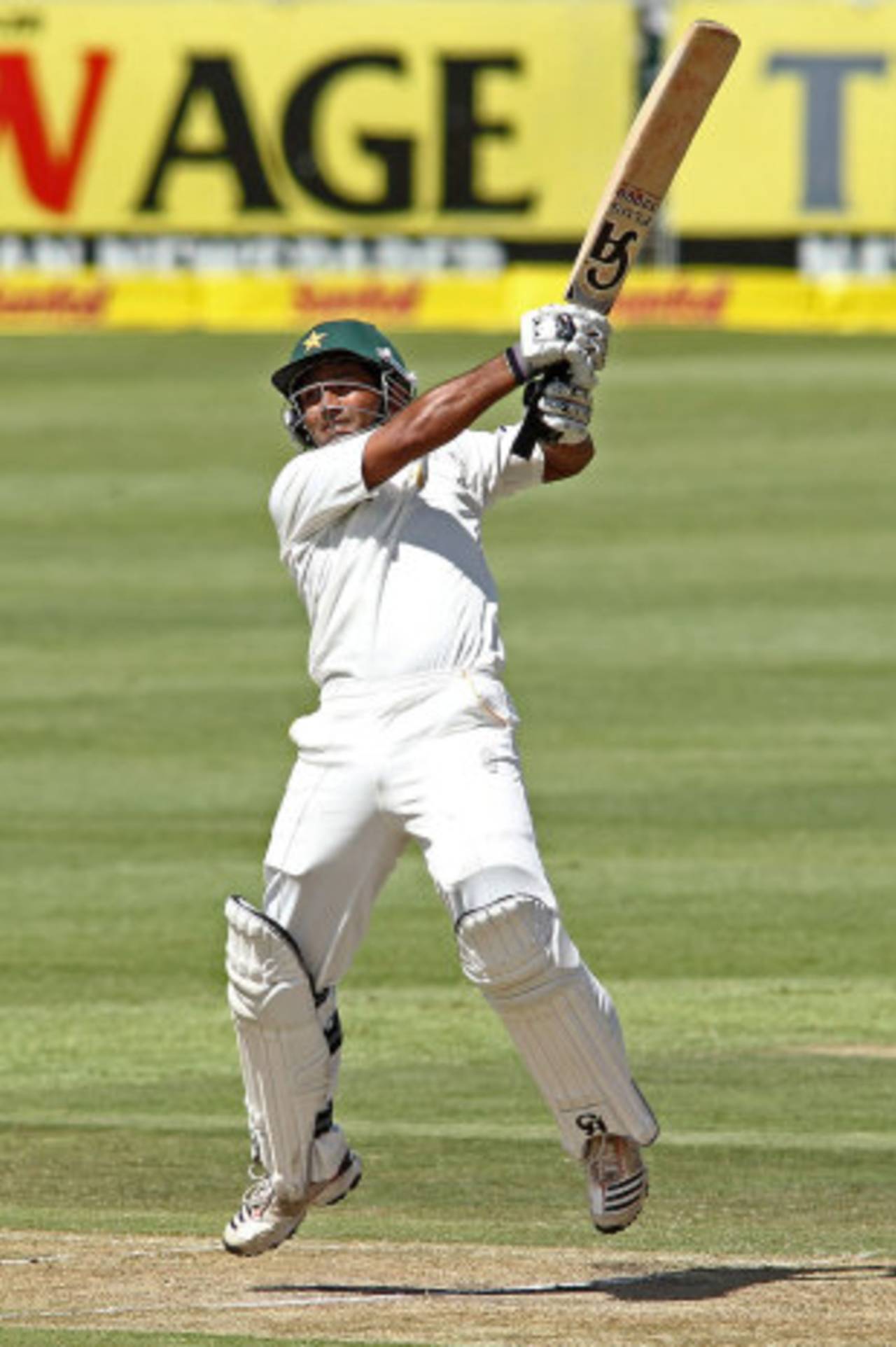Pakistan's anti-performance and other facts from Newlands
A statistical analysis of what went down in Cape Town
Andy Zaltzman
25-Feb-2013

A century in South Africa in his 18th Test? No wonder Shafiq finds it hard to keep his feet grounded • Getty Images
Fact illustrated by the Newlands Test #1: Cricket is a team game
Cricket is not as much of a team game as other team games. But it is a team game nevertheless. The Newlands Test proved this in enough spades to open a half-decent DIY store. Pakistan had individual performances that should have laid the foundations for victory. They also had collective frailties than made defeat almost inevitable. They posted the only two centuries of the match, and had the leading wicket-taker. But they still lost, and quite comfortably ‒ becoming just the
This they achieved because they also had: (c) three significant batting collapses, (d) both openers out for ducks in the same innings, (e) a combined match analysis of 1 for 181 by their opening bowlers, and (f) Vernon Philander, with his Dickensian name and his 19th-century statistics, on the other team.
Thus, Younis and Shafiq's outstanding twin 111s, and Ajmal's ten wickets, ultimately came to nothing, and left those three players in elite company in the annals of Test defeats by teams with two tons and a ten-for. Gavaskar, Amarnath and Bedi were similarly let down by their team-mates at the WACA in 1977-78. No prizes for guessing which two scored the hundreds and which one took the ten wickets. Hobbs, Sutcliffe and Woolley all scored centuries at the SCG in 1924-25, but despite their efforts, and Maurice Tate's heroic 11-wicket bag from 89 eight-ball overs ‒ in today's squad-rotational game, he would have been rested for about 15 months after that kind of workload ‒ England were soundly walloped. Their problem was that they blended those three centuries with 13 single-figure scores (compared to Australia's three - similarly, at Newlands last week, the single-figure dismissal tally was South Africa 2 Pakistan 11).
India lost that high-scoring Perth game in 1977-78 due to a second-innings collapse after their two centurions were out, and because Bedi was left more unsupported than a county championship match on a wet Wednesday afternoon in April in the immediate aftermath of nuclear Armageddon. Chandrasekhar and Venkataraghavan could only manage three wickets between in the match, and those were the final three wickets in the first innings.
Other than these three games, teams boasting two or more centuries and a ten-wicket haul have won 82 Tests and drawn 6. So it took a fairly determined all-round anti-performance for Pakistan to lose in Cape Town, despite three outstanding individual displays in the country that has in recent years been least hospitable to visiting sides. Ajmal became only the fourth spinner to take ten in a Test in South Africa since the Second World War (only Murali had done so since 1957), whilst Younis and Shafiq, coming together at 33 for 4, became the first visiting pair to compile a double-century stand in South Africa since April 2006.
They were also just the third pair to add 200 in South Africa and end up on the losing side. Overall, of the 510 double-century partnerships in Test history, 244 have contributed to a victory, 234 have been in drawn games, and only 32 ‒ just over 6% ‒ have preceded a defeat.
Pakistan's fate in what was a gripping and fluctuating match until their second-innings subsidence was ultimately decided not by the potentially match-winning excellence of Younis and Shafiq's batting and Ajmal's wizardrous tweakery, but by the endemic frailty of their batting ‒ 15 Pakistan batsmen were out for less than 20 in this match. At least this was a step forward on the first Test, when 16 of their 20 dismissals were for 18 or less.
Losing 15 batsmen for less than 20 does not necessarily mean you will lose a Test. But it does certainly give you a headstart in the race to the losing line. Statistically, teams are nine times more likely to lose than win a Test if they do so (47 wins, 430 losses) (thanks be to Statsguru, fount of all knowledge) (or at least, fount of some extremely useless pieces of knowledge).
Fact illustrated by the Newlands Test #2: A Test hundred in South Africa is a good innings
To illustrate how tough batting in South Africa is for visiting teams, particularly this decade, a fact: of the last 11 centuries scored by away batsmen since 2009-10, only two have been scored by players with fewer than 50 caps - New Zealand's Dean Brownlie (in his eighth Test), in the second-innings of a Test that had long been a lost cause, and Asad Shafiq ‒ 18 Tests ‒ last week. Younis was in his 81st Test; previously Cook and Bell posted three figures for England in their 50th and 51st Tests respectively in the 2009-10 series; for India the following season, the undeniably experienced Tendulkar centurionated himself in his 175th and 177th matches; in 2011-12, Australia's only hundred-maker was Clarke (73rd), who was then followed by Sri Lankan veterans Sangakkara (105th) and Samaraweera (70th and 71st).
Fact illustrated by the Newlands Test #3: South African lower-order batsmen aren't quite what they used to be
Robin Peterson's match-turning 84 was the first time a South African batting at 8 or lower has scored 80 in a Test for almost eight years, since Nicky Boje hit 82 against Zimbabwe in March 2005. In the seven years between January 1997, when Lance Klusener slapped a rapid hundred against India batting at 9, and January 2004, when Mark Boucher, batting 8, flayed West Indies with his penultimate Test century, South African lower-order batsmen scored six hundreds, two undefeated 99s, and two more scores in the 80s.
Andy Zaltzman is a stand-up comedian, a regular on the BBC Radio 4, and a writer